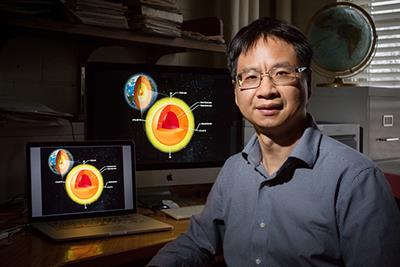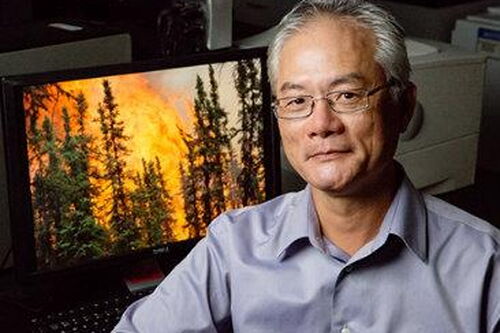Listening for answers

Today we know better than to search for secret tunnels that lead to ancient cities and piles of treasure at the center of Earth, but the question of what lies some 4,000 miles below our feet is still one of humanity’s great mysteries. A research team at the U of I,however, is using seismic waves to shake loose new revelations about our planet’s core.
Using a novel application of earthquake-reading technology, Xiaodong Song, a professor of geology, and Tao Wang, a visiting researcher, along with colleagues at Nanjing University in China, have found that the Earth’s inner core has an inner core of its own, bearing surprising properties that could reveal how our planet evolved.
It is, indeed, some heavy stuff—literally—consisting of iron crystals.
”Even though the inner core is small—smaller than the moon—it has some really interesting features,” says Song. “It may tell us about how our planet formed, its history, and other dynamic processes of the Earth. It shapes our understanding of what’s going on deep inside the Earth.”
The researchers use seismic waves generated by earthquakes to scan below Earth’s surface. The earthquake is like a mallet hitting a bell, and similar to how a musician hears the tone, the researchers are using seismic sensors and technology that gathers data from the shockwaves that resonate in an earthquake’s aftermath.
“It turns out the coherent signal enhanced by the technology is clearer than the ring itself,” says Song. “The basic idea of the method has been around for a while, and people have used it for other kinds of studies near the surface. But we are looking all the way through the center of the earth.”
And doing so revealed a surprise. The inner core, once thought to be a solid ball of iron, has some complex structural properties. The team found a distinct inner-inner core, about half the diameter of the whole inner core. The iron crystals in the outer layer of the inner core are aligned directionally, north-south. However, in the inner-inner core, the iron crystals point roughly east-west.
Not only are the iron crystals in the inner-inner core aligned differently, they behave differently from their counterparts in the outer-inner core. This means that the inner-inner core could be made of a different type of crystal, or a different phase.
“The fact that we have two regions that are distinctly different may tell us something about how the inner core has been evolving,” Song says. “For example, over the history of the earth, the inner core might have had a very dramatic change in its deformation regime. It might hold the key to how the planet has evolved. We are right in the center—literally, the center of the Earth.”
The U.S. National Science Foundation and the National Science Foundation of China supported this work. The team published its work in Nature Geoscience in February.








